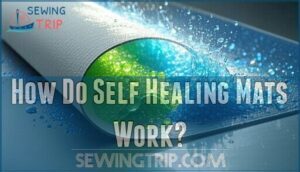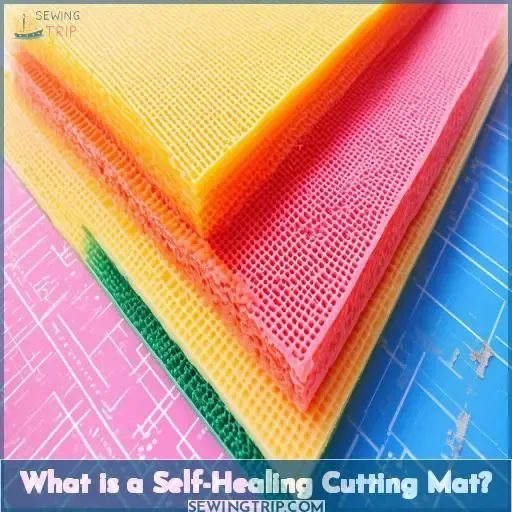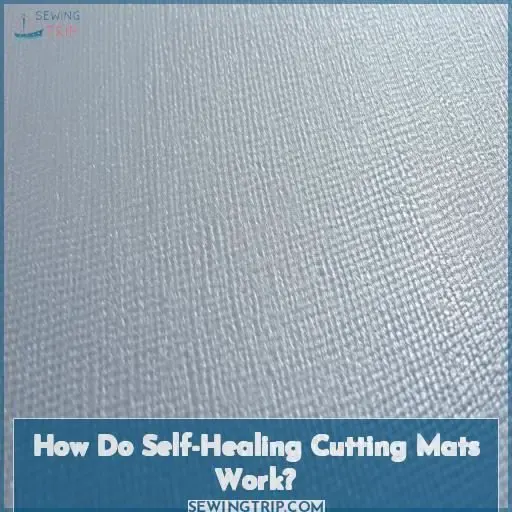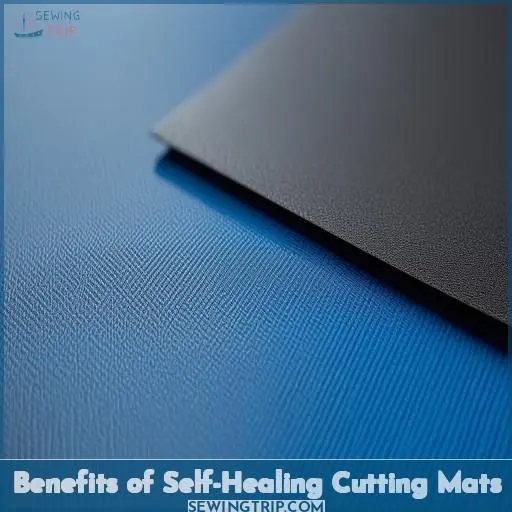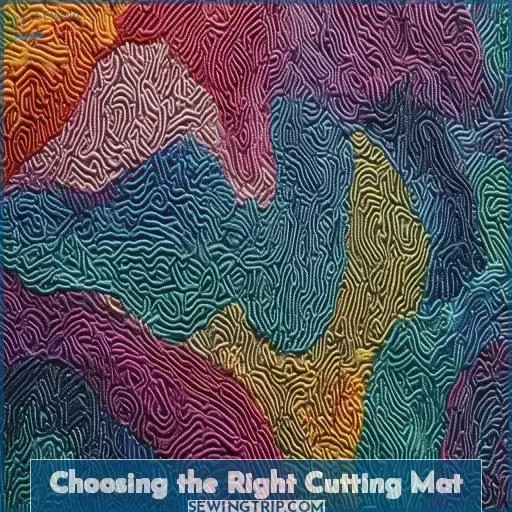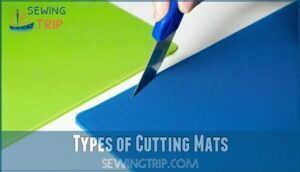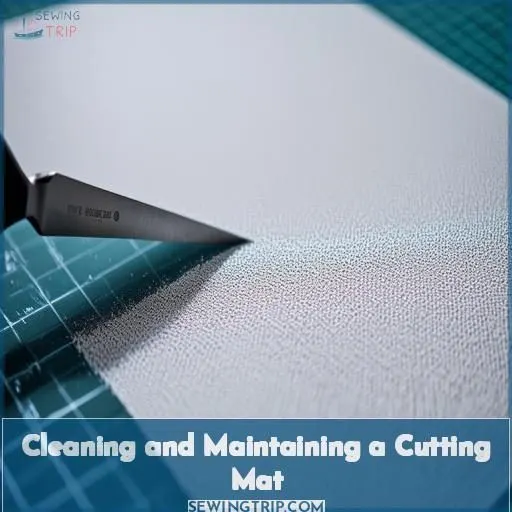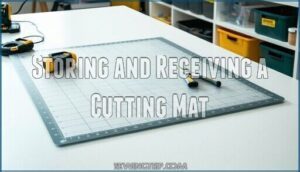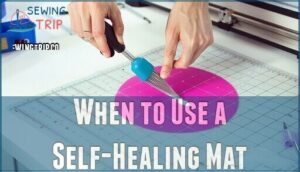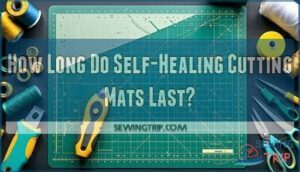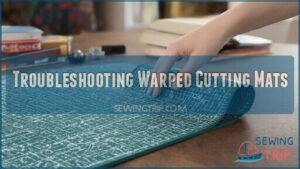This site is supported by our readers. We may earn a commission, at no cost to you, if you purchase through links.
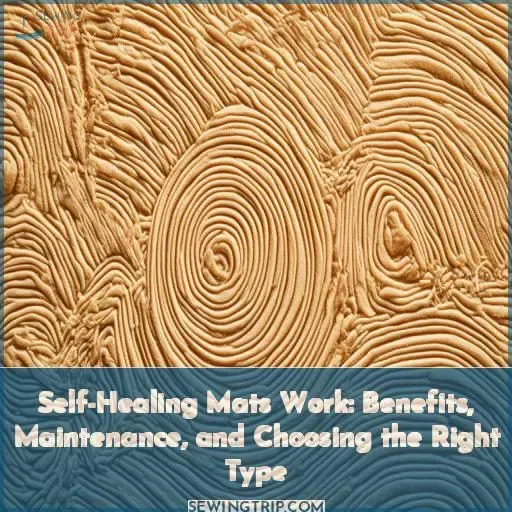 Self-healing mats employ a semi-solid surface infused with tiny particles that rapidly absorb cuts and incisions, allowing the material to promptly replenish itself.
Self-healing mats employ a semi-solid surface infused with tiny particles that rapidly absorb cuts and incisions, allowing the material to promptly replenish itself.
These unique mats aren’t solid – they’re slightly pliable, which enables their self-healing properties.
When you puncture the surface, the particles essentially "swallow" the cut and reform the smooth working area.
This non-solid composition not only ensures remarkable self-healing but also withstands heavy use and handling over time.
And the best part? They’ll keep your tools and blades sharper for longer, protecting your equipment.
Intrigued to learn more about choosing and maintaining the ideal self-healing mat?
Table Of Contents
- Key Takeaways
- How Do Self Healing Mats Work?
- What is a Self-Healing Cutting Mat?
- How Do Self-Healing Cutting Mats Work?
- Benefits of Self-Healing Cutting Mats
- Choosing the Right Cutting Mat
- Types of Cutting Mats
- Cleaning and Maintaining a Cutting Mat
- Storing and Receiving a Cutting Mat
- When to Use a Self-Healing Mat
- How Long Do Self-Healing Cutting Mats Last?
- Troubleshooting Warped Cutting Mats
- Frequently Asked Questions (FAQs)
- Conclusion
Key Takeaways
- These unique surfaces are like a self-repairing superpower – their semi-solid composition is infused with tiny particles that can "swallow" cuts and seamlessly restore the surface, making them incredibly durable and resilient.
- It’s like having a personal bodyguard for your crafting tools – by absorbing the impact of cuts, these mats prevent your blades from dulling prematurely, keeping them sharper for longer and saving you money in the long run.
- Imagine a shape-shifting surface that adapts to your every move, like a faithful sidekick in your creative endeavors – the non-solid nature of these mats allows them to withstand heavy use and handling, ensuring they’ve got your back through all your crafting adventures.
- Think of them as the ultimate multi-taskers, versatile enough to handle any hobby you throw their way – from scrapbooking and quilting to vinyl crafting, these mats are the Swiss Army knives of the crafting world, with their precise grids and durable materials making them indispensable companions.
How Do Self Healing Mats Work?
How do self-healing mats work? Self-healing mats are made of a semi-solid material with tiny particles that can absorb cuts and quickly fill them in due to the non-solid nature, allowing the mat to withstand heavy use and handle numerous cuts without permanent damage.
What is a Self-Healing Cutting Mat?
A self-healing cutting mat protects your work surface from cuts and scratches. It’s made of soft, pliable materials, usually PVC, with layers that measure around 3mm in thickness.
The mat’s surface has a printed grid for precise measurements and alignment. Its self-healing properties come from its ability to close up small cuts and incisions, making the mat durable and long-lasting.
Always store flat, avoid extreme temperatures, and clean with a damp cloth for ideal maintenance and longevity.
How Do Self-Healing Cutting Mats Work?
Self-healing cutting mats function by employing a semi-solid surface comprised of minute particles that absorb cuts and replenish them promptly, preserving the mat’s integrity. This non-solid composition guarantees durability, enabling the mat to withstand strenuous use and handling effectively.
Made of Semi-solid Material With Tiny Particles
Self-healing cutting mats, embodying a semi-solid material filled with tiny particles, leverage their distinct particle composition and material properties to excel. This self-healing mechanism allows the mat to remain durable and reliable, even under heavy use. These attributes guarantee longevity, making them invaluable for a variety of applications .
Absorbs Cuts and Quickly Fills In
When the blade impacts the mat’s surface, the tiny particles shift slightly, absorbing the cut’s pressure. This surface adaptation prevents deep cuts and allows quick restoration. These self-healing materials, combining polypropylene layers, guarantee durability under rotary cutters, while maintaining heat resistance and resilience, optimizing performance and surface regeneration (Source).
Non-solid Nature Allows for Self-healing
The non-solid nature of self-healing cutting mats uses the elasticity of their PVC surfaces to close cuts quickly. This self-healing mechanism involves:
- Elastic surface separating but not fully cutting.
- Tiny particles re-forming to fill the cut.
- Durable materials ensuring longevity.
- Protecting blades cost-effectively.
Withstands Heavy Use and Handling
Self-healing cutting mats are versatile, handling heavy use without losing functionality. Their semi-solid structure withstands repeated cuts from a utility knife, ensuring a longer cutting mat lifespan. For hobbyists, durability comparison favors heavy-duty options like Supaseal and Rhino, which excel in surface comparison, providing longevity and reliability in various crafting tasks.
Benefits of Self-Healing Cutting Mats
Self-healing cutting mats are essential for protecting your work area from damage while extending the lifespan of your blades, allowing you to cut smoothly and precisely. These mats are versatile, durable, and suitable for various hobbies, ensuring long-lasting performance and reliable use .
Protect Work Area From Damage
Self-healing cutting mats are a powerhouse for your workspace, providing protection against sharp tools. With durable materials and easy maintenance, these mats keep surfaces intact during vinyl crafting or using hook weeders. Align grids aid precision, enhancing your crafting versatility .
Prevent Knives and Tools From Dulling
Using self-healing cutting mats prevents knives and tools from dulling by absorbing the impact of cuts, maintaining surface integrity for precise, straight cuts. These mats, whether Rhino cutting mats or heavy-duty anti-static versions, guarantee durability, cost-effectiveness, and exceptional tool performance.
Extend Blade Lifespan
With a self-healing cutting mat, you extend blade sharpness notably. This leads to extended blade longevity and enhances knife durability, ensuring your tools perform consistently and effectively. This mat preserves the cutting mat lifespan, maintaining suitable conditions for your cutting projects .
Versatile for Various Hobbies
Self-healing mats are versatile for hobbies such as scrapbooking, quilting, and vinyl crafting. Their resilience and ease of maintenance make them indispensable tools. You’ll appreciate the precise cuts and alignment grids that simplify your craft projects (Source).
Durable and Long-lasting
Durability and longevity come naturally with self-healing cutting mats, ensuring effective use over time. Proper care and upkeep, like routine cleaning and storing flat, make these mats cost-effective, maintaining your cutting surface in excellent condition for all your crafting needs.
Choosing the Right Cutting Mat
When choosing a cutting mat, measure the available space and decide on a thickness of either 3mm or 5mm. Opt for a green, SupaSeal, or heavy-duty mat, and be sure to select one with anti-glare and anti-static properties .
Measure Intended Space
To guarantee effective use of your self-healing cutting mat, measure your workspace accurately. Consider these three measuring techniques:
- Utilize a tape measure for precise dimensions.
- Account for space efficiency to fit snugly.
- Ensure grid precision for seamless projects.
Determine Thickness (3mm or 5mm)
When determining thickness, choose between 3mm or 5mm based on your needs. A 3mm mat is pliable and great for light-duty tasks, while 5mm offers more durability and rigidity for heavy-duty use .
Consider Surface Type: Green, SupaSeal, or Heavy-duty
Consider the surface type when choosing a cutting mat:
- Green: Cost-effective, double-sided, heat-resistant.
- SupaSeal: Translucent, superior self-healing, anti-static properties.
- Heavy-duty: Opaque white, firm, double-sided with both smooth and textured surfaces.
- Transparent mats: Allow for easy cost comparison and anti-glare properties.
Avoid Reflective or Textured Surfaces
When choosing a cutting mat, avoid reflective or textured surfaces. Reflective surfaces create glare, blinding your view, while textured surfaces can cause uneven cuts. Opt for non-reflective mats to guarantee clarity and precision in your work, enhancing efficiency and safety .
Ensure Anti-glare and Anti-static Properties
When choosing a cutting mat, focus on anti-glare coatings and anti-static charges. Confirm it has these features:
- Reduces eye strain with anti-glare coatings.
- Prevents static build-up.
- Avoids reflective surfaces.
- Avoids textured surfaces for seamless work .
Types of Cutting Mats
When choosing a cutting mat, consider a Green Self-Healing Cutting Mat for its cost-effectiveness and double-sided heat-resistant features. Alternatively, a SupaSeal Cutting Mat offers exceptional self-healing properties and anti-static functionality, making it an excellent choice for more specialized tasks.
Green Self-Healing Cutting Mat: Cost-effective, Double-sided, Heat-resistant
When considering a cutting mat, the verdant self-healing option stands out. It’s cost-effective, making it an excellent choice for hobbyists on a budget.
This mat is double-sided, so you can get extended use before needing a replacement. Its heat resistance ensures it won’t warp or degrade over time. Plus, the durability of this mat means it can handle a variety of cutting tasks without losing its self-healing properties.
Green self-healing cutting mats provide a perfect balance of affordability and functionality, making them a go-to option for enhancing your crafting experience (Source).
SupaSeal Cutting Mat: Translucent, Exceptional Self-healing, Anti-static
The SupaSeal cutting mat stands out for its translucent quality, offering exceptional self-healing and anti-static properties, providing superior work area protection.
Ideal for precision tasks, its surface re-seals cuts seamlessly, preserving both the mat and your blades. The anti-static nature prevents material shifts, ensuring accuracy and ease during complex cuts.
Whether you’re engaged in crafting, model-making, or intricate art projects, this mat caters to your need for reliability and precision. Its flat, durable build withstands persistent use, making it indispensable for maintaining a pristine, efficient workspace.
Invest in a SupaSeal for exceptional, long-lasting performance and immaculate cuts every time.
Cleaning and Maintaining a Cutting Mat
To maintain your self-healing cutting mat, use a lint roller to remove any fibers or debris that may have accumulated on the surface. Wipe down the mat with a non-cotton towel, avoiding harsh chemicals and extreme temperatures, which can damage the material’s self-healing properties.
Use Lint Roller to Remove Fibers
Use a lint roller frequently to remove any loose fibers, threads, or debris from the mat surface. This simple step will:
- Prevent fiber buildup that obstructs blade paths
- Maintain the mat’s self-healing capability
- Extend the lifespan of your cutting tools
Wipe Down With Non-cotton Towel
After using a lint roller, grab a non-cotton towel and gently wipe down the surface. This simple step removes stubborn marks without damaging the self-healing properties. Avoid using towels with lint, as these can embed fibers into the mat, compromising its integrity.
Avoid Harsh Chemicals and Extreme Temperatures
When cleaning, avoid harsh chemicals and extreme temperatures. You should:
- Steer clear of solvents or cleaners with bleach
- Never expose your mat to heat above 95°F (35°C)
- Store in a cool, dry place away from direct sunlight
Proper care prevents material breakdown, ensuring your self-healing mat lasts for years of crafting bliss.
Rotate and Flip Mat Regularly to Prevent Scarring
Rotating and flipping your cutting mat regularly is essential for long-term use and mat durability. This evenly distributes the cutting surface’s abrasion, preventing excessive wear in one area and ensuring consistent grid alignment. Regularly maintaining your mat’s orientation maximizes its self-healing properties, extending its lifespan for years of reliable crafting.
Storing and Receiving a Cutting Mat
When storing your self-healing cutting mat, it’s important to keep it flat and away from direct light or heat sources to prevent warping. Avoid rolling or bending the mat during storage, and allow it to lay flat for at least 24 hours before use to dissipate any lingering plastic odor and allow the surface to fully settle.
Store Flat, Away From Light and Heat
You’ll want to store your self-healing cutting mat flat, avoiding light and heat exposure. This flat storage prevents warping, ensuring long-term durability and workspace protection. With proper care, your cutting mat remains a reliable surface for precision crafting.
Avoid Rolling or Bending
Treat your self-healing mat like the pro you’re – avoid rolling or bending it during storage. This prevents creases and warping that could ruin your flat workspace’s integrity. Keep it lying flat, protecting its healing powers for your next crafting adventure.
Lay Flat for 24 Hours Before Use
Upon unpacking, allow your new self-healing mat to rest flat on a surface for 24 hours prior to use. This guarantees ideal flatness and prevents deformation caused by storage or transportation. Lay it flat to acclimate – a simple step that preserves its precise cutting surface.
Plastic Odor May Dissipate in 24 Hours
You may notice a plastic odor when first receiving your new cutting mat. Don’t worry – this is normal and will dissipate in 24 hours as the mat acclimates. Follow these tips:
- Lay flat
- Provide airflow
- Avoid heat sources
- Be patient
The odor results from manufacturing but quickly fades, leaving your mat ready for crafting.
Replace Warped Mats and Identify Cause
If your cutting mat becomes warped from heat exposure, moisture damage, or improper storage, it’s time for a replacement. Identify the culprit to prevent further warping, and invest in a high-quality mat that can withstand your crafting demands.
When to Use a Self-Healing Mat
You’ll want to use a self-healing cutting mat when doing vinyl crafting with tools like awls or hook weeders, as it protects your table surface from scratches and punctures. The mat’s inch grid and metric/imperial rulers make measuring and aligning your crafts easy, while the damp cloth cleaning and flat storage help maintain its quality.
Vinyl Crafting (awls, Hook Weeders)
When crafting with vinyl, a self-healing mat is essential for precision cutting using awls and hook weeders. These mats protect both your project surface and tools, making them hobby essentials for guided vinyl designs.
Protects Table Surface From Scratches and Punctures
You’ll avoid scratches and punctures on table surfaces by using a self-healing cutting mat. Its durable materials protect workspaces while boosting cutting efficiency and blade longevity – a worthwhile investment for any crafter.
Inch Grid for Easy Measurement and Alignment
You’ll appreciate the inch grid, offering easy measurement and alignment. It’s a handy feature, ensuring:
- Precise cuts
- Straight lines
- Accurate sizing
- Professional results
With various size options and grids, find the mat suited to your needs, whether intricate crafting or simple trimming.
Metric and Imperial Rulers on Each Side
You’ll also find metric and imperial rulers on each side, simplifying measurements and alignment for precise cuts. These handy guidelines guarantee your projects come together seamlessly.
Clean With a Damp Cloth, Avoid Heat, Store Flat
When cleaning, use only a damp cloth; avoid harsh chemicals that could degrade the mat’s surface. Store your self-healing mat flat to prevent warping. Proper storage and maintenance techniques preserve its longevity, letting you craft without damaging your work area.
How Long Do Self-Healing Cutting Mats Last?
The lifespan of a self-healing cutting mat depends heavily on how often you use it and how well you maintain it. With proper care, including regular cleaning, avoiding heat and moisture exposure, and storing it flat, a high-quality self-healing mat can typically last for years of regular use before needing replacement due to excessive scarring or warping.
Depends on Frequency of Use and Care
A self-healing cutting mat’s lifespan depends on how often you use it and how well you care for it. With heavy, frequent use, it’ll need replacing sooner than with light, occasional crafting. Proper maintenance like cleaning, rotating, and storing it flat can extend its life considerably.
Proper Maintenance Extends Lifespan
With proper maintenance, you’ll extend your self-healing cutting mat’s longevity. Regularly wipe it down, avoid harsh chemicals, rotate and flip it to prevent scarring, and store it flat. These maintenance tips guarantee your mat’s self-healing abilities endure, maximizing its lifespan and value.
Replace When Heavily Scarred or Warped
You’ll know it’s time for a new self-healing cutting mat when the surface becomes heavily scarred or warped. Scarring prevents the mat from fully repairing, while warping creates an uneven cutting surface. Both issues stem from heavy use and improper care – easily preventable with proper maintenance.
Typically Last for Years With Regular Use
With regular use and proper care, self-healing cutting mats can last for years. Their semi-solid nature and careful production process guarantee remarkable durability, protecting your work surface while extending the life of your knives. Cost-effective and essential for countless creative projects, these mats offer unbeatable value.
Troubleshooting Warped Cutting Mats
Cutting mats can warp due to heat exposure, moisture, or improper storage. If your mat is warped, try laying it flat and weighing it down to flatten it out; avoid placing heavy objects directly on the warped surface, and consider replacing the mat if flattening doesn’t work.
Caused by Heat, Moisture, or Improper Storage
Heat, moisture, and improper storage are common culprits behind warped cutting mats. You’ll notice:
- Curled edges from heat exposure
- Bubbling or ripples from moisture damage
- Bending or twisting from poor storage conditions
- Uneven surfaces that make precise cuts difficult
- Gradual warping over time, affecting cutting precision
Don’t let warping ruin your crafting experience – address the root causes promptly.
Lay Flat and Weigh Down to Flatten
If your cutting mat has warped, lay it flat and weigh down the corners or edges with heavy books or objects. This gentle flattening process can help reshape the mat over time.
| Weights | Book Stacks | Bricks | Dumbbell Sets |
|---|---|---|---|
| Flatten | Reshape | Realign | Unbend |
| Corners | Edges | Centers | Full Surface |
| Overnight | 24 Hours | 1 Week | As Needed |
Avoid Placing Heavy Objects on Warped Mat
Don’t compound the issue by placing heavy objects on a warped mat. This added pressure can further warp the mat, making it challenging to repair. Instead, gently lay the mat flat without weights. Store mats properly to prevent warping from heat or moisture exposure.
Replace if Flattening Doesn’t Work
If flattening your warped cutting mat fails, you’ll need to replace it. Prolonged warping can damage the self-healing properties and ruin its functionality. Avoid this by properly storing your mat and addressing warping early. If the reasons behind the warping persist, replacement is your best bet to avoid further issues.
Frequently Asked Questions (FAQs)
How long does a self-healing cutting mat last?
With proper care, a self-healing cutting mat can provide years of service. Regularly cleaning and storing it flat prevents warping or excessive wear. Rotate and flip it frequently to avoid permanent indentations. When maintained well, these versatile mats retain their self-healing capabilities for an impressively long time.
How do you heal self-healing cutting mats?
Think of it like a self-repairing muscle. These mats are made of tiny fibers that separate when cut, then squeeze back together, healing the "wound." No separate efforts are needed – give it time, and those malleable materials will mend themselves automatically.
Why is it called self-healing cutting mat?
It’s called "self-healing" because the unique surface instantly closes cuts made by crafting tools, restoring itself like new. The mat effectively "heals" on its own after each use.
When should I replace my self-healing mat?
You’ll know it’s time for a new self-healing mat when the cuts no longer close up like they’re regenerating. Even the most stubborn scars will eventually yield to a fresh, undamaged surface – that’s cutting mat mastery!
Are self-healing mats safe for childrens crafts?
Yes, self-healing mats are safe for kids’ crafts. The materials are non-toxic, making them an ideal cutting surface that protects your little artisans from harm. Just remember to supervise young ones when using sharp tools.
Can self-healing mats be used for food preparation?
Crafting countertops call: chop chestnuts, never creamy cheese. Self-healing surfaces strategically separate instead of slicing, restoring resilience. Their texture transmits tastes terribly, tainting toppings – avoid for food prep purposes.
How often should self-healing mats be replaced?
You’ll need to replace self-healing mats occasionally – around every 6-12 months with regular use. Inspect them regularly for deep scars or deformities that impair performance. Proper care and rotation extends their lifespan, but replacement becomes necessary over time.
Do self-healing mats require any special treatment?
You’ll want to store self-healing mats flat, rotating and flipping them regularly. Use a damp cloth for cleaning – avoid harsh chemicals that could damage the mat’s self-healing properties.
Are there environmentally-friendly options for self-healing mats?
Eco-friendly self-healing mats crafted from recycled materials offer an eco-conscious choice, aligning your passion for crafting with environmental harmony. Express your creativity sustainably!
Conclusion
Self-healing mats offer remarkable versatility and longevity.
What makes them truly invaluable is their ability to rapidly absorb cuts and incisions, promptly replenishing the smooth working area.
This unique self-healing mechanism is facilitated by a semi-solid composition infused with tiny particles.
It not only protects your tools but also withstands heavy use.
With proper maintenance, these mats can be your trusted companion for years, ensuring precise results across various hobbies and projects.

